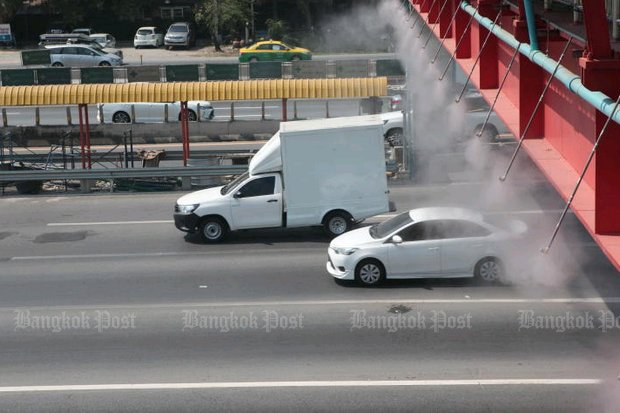
Bangkok Metropolitan Administration (BMA) has declared pollution control zones across the capital and its vicinity, in an effort to help reduce the levels of PM2.5 dust that has blanketed the area for several weeks, said Bangkok Governor Aswin Kwanmuang.
Pol Gen Aswin said areas where the levels of ultra-fine particulate matter exceed the safe threshold of 50 microgrammes per cubic metre (µg/m³) will be subject to new measures set out by the BMA.
First, he said, the area where PM2.5 levels exceeds the safe threshold set by the Pollution Control Department will be declared as a pollution control zone.
Stringent measures -- which include issuance of warnings, road closures and/or detours, and restrictions on emissions by businesses -- will rolled out in areas where PM2.5 levels are considered unhealthy, said Pol Gen Aswin.
Authorities will focus on pollution-prone areas, such as Intharaphithak Road in Bang Khunthian, the stretch of Rama II Road near Phan Thai Norasing Shrine in Samut Sakhon, as well as Sathon Road and Phahon Yothin Road in front of Kasetsart University, he added.
"As for schools in the declared zones, they would be told to suspend outdoor activities," said Pol Gen Aswin, adding classes may have to be suspended, but the decision will ultimately lie with the schools.
Pol Gen Aswin revealed the plan at a meeting chaired by Natural Resources and Environment Minister Surasak Kanjanarat, which sought to find ways to address persistent haze.
Gen Surasak said the meeting agreed that over the next 3-5 years, the average levels of PM 2.5 pollutants must drop to 35 µg/m³.
In 10-20 years time, the level must fall between 25-35 µg/m³, he added.
"Provincial governors have been authorised to declare pollution control zones in cases of severe haze outside of Bangkok," Gen Surasak said.
Separately, Prime Minister Prayut Chan-o-cha said after Tuesday's cabinet meeting that the haze that has shrouded Bangkok and its five surrounding provinces is a pressing problem that cannot be addressed in a short period of time.
The National Environment Board, chaired by Deputy Prime Minister and Defence Minister Prawit Wongsuwon, has been assigned to consolidate efforts between various agencies to tackle the problem, the premier said.
Urgent measures, including spraying water on roads, have been carried out, which have helped ease the haze to some extent, he said.
"More efforts should be made to spray water from high-rise buildings, such as Baiyoke Tower," said Gen Prayut.
Government spokesman Buddhipongse Punnakanta said that during the Chinese New Year celebrations next week, concerted efforts will be made to help boost public understanding that the tradition of burning incense, as well as gold and silver papers, during the festivities can also contribute to the haze.
- Earlier report: Toxic levels soar on Tuesday
- Commentary: EEC will aggravate pollution